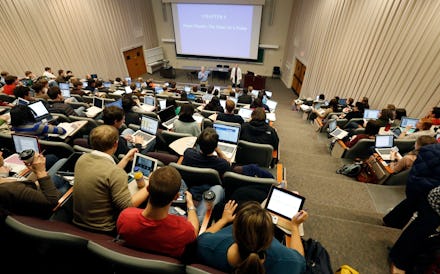According to Science, College Professors Have Been Teaching You All Wrong

The news: Lectures might actually be boring their students right out of good grades. A new study published in the Proceedings of the National Academy of Sciences has found that undergraduate students in classes with traditional "stand and deliver" lectures are 1.5 times more likely to fail than students taught using other, more creative methods. Instead, teachers should take "active learning" to heart:
"Active learning engages students in the process of learning through activities and/or discussion in class, as opposed to passively listening to an expert. It emphasizes higher-order thinking and often involves group work."
Basically, science has provided evidence that this ...
... actually happens.
The background: To compile his data, biologist Scott Freeman of the University of Washington analyzed 225 studies of undergraduate STEM teaching methods. The meta-analysis concluded that rather than engaging and enlightening students, the "sage on a stage" approach wasn't nearly as effective as active teaching methods. Turning students into active participants didn't just get their attention, it improved their grades by almost one-half of a standard deviation.
"The change in the failure rates is whopping," Freeman told ScienceMag. And the exam improvement — about 6% — could, for example, "bump [a student's] grades from a B– to a B."
In practical terms, switching from straight lecturing to active teaching and engagement methods could prevent tens of thousands of students from flunking out of or dropping STEM courses (something America can't really afford these days). And switching up lectures with active learning techniques can be kind of easy. Asking students to answer questions with handheld clickers, calling on individuals or groups randomly or having student reach consensus with or clarify information to each other are all small adjustments that can have a big impact.
Harvard Physicist Eric Mazur, who was not involved in the study but has been campaigning for better lecturing techniques for more than 20 years, said: "This is a really important article — the impression I get is that it's almost unethical to be lecturing if you have this data. It's good to see such a cohesive picture emerge from their meta-analysis — an abundance of proof that lecturing is outmoded, outdated, and inefficient."
Freeman also argues that "There is a growing body of evidence showing that active learning differentially benefits students of color and/or students from disadvantaged backgrounds and/or women in male-dominated fields. It's not a stretch to claim that lecturing actively discriminates against underrepresented students."
What's more, other studies (Van Heuvelen in Am. J. Physics; Deslauriers et al. in Science) have even found that students paired with award-winning lecturers learned less than inexperienced teachers who used active learning techniques.
These findings shouldn't be surprising: People have been criticizing the lecture model as outmoded for decades. Despite this, it's remained the dominant teaching method since the first Western European universities were founded around 1050 — even though a lot has changed since then. For example, professors are now competing with rampant electronics use in lecture halls.
But active teaching approaches are difficult to implement considering the monstrous class sizes common in many public universities, particularly in first-year classes. A recent review of the literature on class size found that smaller classes have "higher levels of student engagement, increased time on task and the opportunity small classes provide for high-quality teachers to better tailor their instruction to the students in the class." A study by Charles C. Bonwell says that while larger class sizes can prevent effective implementation of active learning strategies, teachers and professors still have other tools like dividing classes into "small groups for discussion activities" and letting writing assignments be read and critiqued by other students.